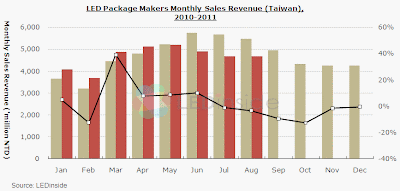LEDinside indicates that the oversupply will continue to hover around the LED industry in the next few years. In light of the unfavorable market outlook, Chinese LED chip makers have put their expansion plans on hold – a number of manufacturers have delayed production plan, postponed MOCVD installation plan and even considered exiting the market. Therefore, LEDinside estimated the number of new MOCVD equipment installed in China in 2011 at less than 400 units, which is expected to have a positive impact on LED price in 2012. Moreover, as the competition in the LED industry intensifies, Taiwanese manufacturers’ fast responses to the changing economic climate give them a better chance of making inroads into the global LED industry.
 Source: LEDinside, Taiwan.
Source: LEDinside, Taiwan.Chip makers' revenue performance
LED makers faced the pressure of readjusting the percentages of their backlight and lighting products in 2Q11. Although large-sized backlight remained the LED chip makers’ target market, the inventory pressure and weak demand in the end market, LED chip makers continue to experience revenue challenges.
In August 2011, listed Taiwanese LED chip makers totaled NT$ 3.72 billion (MoM-5.9 percent, YoY-23.9 percent). However, Formosa Epitaxy Inc. managed to deliver a decent revenue of NT$ 380 million with a 14.6 percent MoM increase, which mostly attributed to the lowered base period value caused by decreased orders from South Korea in 1H11 and the revenue rebound after August.
LED makers stated that they started receiving rush orders for tablet and mobile device backlights in September; certain panel manufacturers’ new LED TVs have not only propelled demand but also revived the industry.
At the moment, Chinese LED chip makers are drastically adjusting their MOCVD purchase plans and re-distributing its capacities. These moves are a reaction to LED market’s oversupply, Chinese government’s subsidy decrease, the cost of MO source surpassing its actual revenue, and the shortage of Taiwanese LED engineers.
Facing such an economic downturn, major Chinese LED makers, such as Sanan Optoelectronics, Elec-Tech International and GCL-Poly Energy Holdings, became conservative about their expansion plans and plan to install less MOCVD equipment than planned. Hence, LEDinside predicts that under 400 sets of new MOCVD equipment will be installed in China in 2011, which is good news as far as the LED price trend in 2012 is concerned.
 Source: LEDinside, Taiwan.
Source: LEDinside, Taiwan.Package manufacturers' revenue performance
In regards to revenues of Taiwanese LED package manufacturers, dampened by the weak backlight market demand and drop in LED chip price, the Aug’11 revenues of listed Taiwanese LED package manufacturers totaled to NT$ 4.69 billion, a sharp decline of 14.5 percent compared to the same time last year and 0.01 percent when compared to July 2011.
However, Lextar’s LED package revenue, which has made its way into the lighting market, reached NT$ 760 million, which is a 17.9 percent growth from July’11. Lextar’s growth momentum can be mainly attributed to lighting products, which is 40 percent of its total revenue. Lextar began receiving orders for large LED lighting projects at the beginning of 2011.
At present, LED tubes account for majority of its shipment, averaging 2,000-3,000 thousand tubes per month. Moreover, GX16 tube launched in 2Q11, which conformed to the JEL801 standard, has seen considerable shipment growth as well.
 Source: LEDinside, Taiwan.
Source: LEDinside, Taiwan.From a general perspective, the LED lighting market has been demonstrating steady growth, even though the pace has fell short of the industry's expectations. Traditional lighting manufacturers benefiting from the OEM orders from Japan indicated that, aside from GX16 light tubes, R17D light tubs also made a big impact in the Japanese market.
According to LEDinside, May to August is the peak season for commercial lighting, and October to December for residential lighting. If the Japanese government reinstitutes the Eco-Point policy in 2H11, LED is expected to see a significant growth in the residential lighting market.
 Source: LEDinside, Taiwan.
Source: LEDinside, Taiwan.




No comments:
Post a Comment
Note: Only a member of this blog may post a comment.